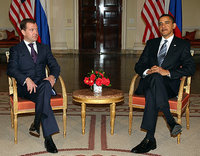For the past 20 years, American and Russian policymakers have been searching for "the big thing" that would serve as the foundation for an effective and durable partnership between the two countries. In the months following Sept. 11, for instance, there was a sense that the "war on terror" might recreate a "grand alliance" between Moscow and Washington akin to the World War II partnership against the Nazis. But grandiose schemes for a revamped European security architecture and even a U.S.-Russia strategic alliance have foundered because realities could never match the rhetoric.
Learning from these missteps, the Obama and Medvedev administrations have instead concentrated their efforts on small-scale projects, to build up the habits of cooperation between the two countries, especially their defense and national security establishments. Ironically, Afghanistan, which two decades ago was one of the principal geopolitical battlefields of the Cold War, is now one of the areas where the "reset" is showing the most concrete results.
Over the past two years, Russia has emerged as an alternative to Pakistan as the conduit of choice for supplies to support the U.S. and NATO mission in Afghanistan. The so-called Northern Distribution Network (NDN) is a logistical corridor (.pdf) "connecting Baltic and Black Sea ports with Afghanistan via Russia, Central Asia and the Caucasus." Initially conceived as an alternative transit route for nonlethal supplies, the NDN has grown in importance over the past two years and now accounts for more than half of all U.S. military transit to Afghanistan. That is in part due to the unreliability of supply routes from the Pakistani port of Karachi, which are plagued by security concerns as well as temporary closures by the government in Islamabad. But it is also due to the Russian government's decision to allow the transfer of military equipment as well as food and fuel across its territory. For the past year, Moscow has permitted U.S. planes to transit Russian airspace carrying troops and weaponry, with up to 4,500 flights authorized annually.

